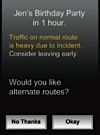Sensing the world with mobile devices

By putting mobile phones in the hands of human participants, we can take advantage of users as creators, custodians, actuators, and publishers of the data they collect.
That’s a good thing, because the physical world contains more sensory data than we can possibly comprehend. Even while moving across great distances, humans narrow down observations via critical decisions, reality checks, and inferences. Which data is important? How much do we need? How can we use the data to tell a better story? Humans make opportunistic choices on the spot, taking into consideration immediate factors not possible using digital methods.
A people-centric sensing network would behave much like a self-organizing organic system, with personal data interplaying in fluid and unpredictable ways with environmental, community, and global data. And since the data is organic by nature, it calls to mind an ecosystem more than an architecture—capable of self-assembling dynamically as the data and its constructs shift and expand.
(Check also this website on Nokia’s SensorPlanet project)




[…] this time by LIFT’s Fabien Girardin, and it’s as if he is taking the Nokia paper I just wrote about one step further: “In the past, sensors networks in cities has been limited to fixed sensors, […]
[…] just found that Nokia has done a great deal of work regarding this (via Putting People First), in a concept they call Sensing (Download […]
[…] Via Putting people first. […]
[…] found this recent paper published by the Nokia Research Center (via Putting People First) an extremely interesting read. It echoes and builds on some thoughts I’ve been having recently […]